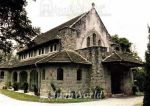We've tried to ensure the information displayed here is as accurate as possible. Should there be any inaccuracies, we would be grateful if you could let us know at info@ipohworld.org . All images and content are copyright.
(Please click on the thumbnail for a bigger image.)
St Andrew’s Presbyterian Church, Ipoh - A Brief History

The church was built in 1929 and opened in 1930 at No.47, Golf Club Road (Jalan Kelab Golf), Ipoh. According to some early records, this initiative was undertaken by the Ipoh Golf Club and the St Andrew's Society. The site was given to the congregation free of charge by the State Government; and the contracting architect was the firm of Stark & McNeill.
It was Ipoh’s first Presbyterian minister George Nicol who spent two years organizing the funding and construction of the church. He was there for the laying of the foundation stone by Arthur Worthington in March, 1929 but, alas, he had to leave Ipoh for Home before the building was completed and the first services held. That is how it came to be that his replacement, John B. Walker, who had taken over only in May, officiated at the consecration in October.
Laying the foundation stone of the church was one of Worthinton's s last official acts before retirement.
The church was built to serve the expatriates who were mostly from Scotland; these expatriates were planters before the war. Previously, a minister used to conduct services (for both the planters and the estate workers) in Taiping, Teluk Anson (Teluk Intan) Bagan Datoh, Sungkai, Batu Gajah, Sungai Siput and Gula. The last minister before the war was John Flemming, a Manchurian Missionary who later retired in Scotland.
Dr John Roxborogh, who lectures in Theology at the Theologian Seminary of Malaysia (Seminari Teoloji Malaysia), recalls some excerpts from a letter by Rev Flemming:
* “One of the last acts of the session clerk that year was to apply for permission for Rev Flemming to conduct weddings. But instead, Rev Flemming found himself driving trucks and ambulances as the British defences withdrew.”
“...services were disrupted due to brown-outs and other duties connected with hostilities preventing members from attending service at the usual hour.”
The Japanese arrived in Ipoh on 28th December 1941 and barely 2 years after, the British surrendered in Singapore. With that, the expatriate congregations were gone and the remaining leadership was interned at the Changi camp in Singapore. St Andrew's Church was then taken over by the Chinese Synod, which continued to hold regular services.
During the Malayan Emergency, the church had financial difficulties in obtaining expatriate ministers. According to Dr Roxborogh, the church itself had “a peculiar congregation...there was never enough money and the minister never stayed as long as hoped”.
By the mid 1960s, St Andrew's last European minister left and Rev Jeremy Law laid the foundation for the present Chinese congregation. Dr Roxborogh further states that “the church has served its purpose for the colonial era and now it has a new life”. This ‘new life’ is seen in the way the church has provided facilities for others (of different cultures and languages) who share the same faith.
The picture shown is of St Andrews at its present location (Golf Club Road).
* Note: This pre-war letter was said to have been addressed to the Straits Echo, Penang.
To see a press cutting about St Andrew's Church history, click here.